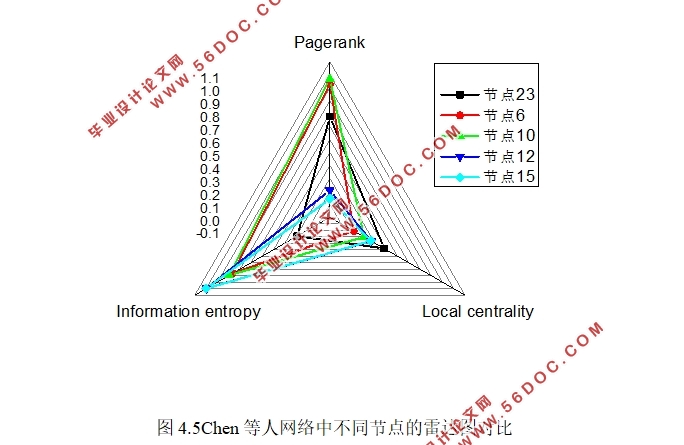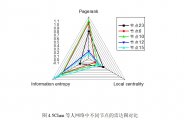基于机器学习的网络节点影响力分析与设计(任务书,开题报告,外文翻译,论文16000字)
摘要
在复杂网络中,对网络节点的中心性(或称影响力、重要性)的评估一直以来都是一个重要的研究主题。节点的影响力直接决定了网络的性质和特点,在搜索引擎、社交网络、电力系统、生物生态系统等诸多领域有着重要的应用。本文首先对度中心性(Degree centrality)、介数中心性(Betweenness centrality)、Pagerank等方法进行了回顾和分析,接着信息熵/信息维度模型和k-medoid聚类模型进行了深入的分析,并基于这两种方法的基础上提出了一种k-path optimization算法,该算法相较于之前的方法,显著降低了计算复杂度,并且在小世界网络上效果十分突出。
论文主要研究了对于信息熵/信息维度模型进行简化的可能性、与k-medoid方法相似的优化方法的可行性,进而对所提出的算法进行优化、测试,并与其它方法进行对比。此外,本文还提出了一种基于雷达图的多维度节点影响力评估方法,改变了由单一中心性指标进行评价的传统方式。
研究结果表明:k-path optimization算法相较于之前的方法,显著降低了计算复杂度,并且在小世界网络上效果十分突出。
本文的特色:提出了k-path optimization算法、提出了基于雷达图的多维度节点影响力评估方法。
关键词:机器学习;复杂网络;节点影响力;小世界网络;传播影响力
Abstract
In complex networks, the assessment of the centrality of nodes has always been afundamental issue. The influence of the node directly determines the nature and characteristics of the network, and has important applications in many fields such as search engines, social networks, power systems, and biological ecosystems. In this paper, the methods Degree centrality, Betweenness centrality and Pagerank are reviewed and analyzed. Then the information entropy/information dimension model and k-medoid clustering model are deeply analyzed. Based on these two methods, a k-path optimization algorithm is proposed. Compared withprevious methods, the algorithm in this paper significantly reduces the computational complexity and is very effective on Small-world Networks.
The paper mainly studies the information entropy/information dimension model and the feasibility of the optimization method similar to the k-medoid method. Then the proposed algorithm is optimized, tested and compared with other methods. In addition, this paper also proposes a multi-dimensional node influence evaluation method based on radar chart, which changes the traditional way of evaluation by a single centrality.
The research results show that the k-path optimization algorithm significantly reduces the computational complexity compared with the previous method, and the effect is very prominent on the small world network.
The characteristics of this paper: The k-path optimization algorithm is proposed, and the multi-dimensional node influence evaluation method based on radar chart is proposed.
Key Words:Machine Learning;Complex Network;Node Influence;Small-world Network;Communication Influence
本文研究工作与内容安排
本文首先介绍识别复杂网络中各个重要节点的方法,然后将会介绍信息维度方法、聚类方法、传播模型和小世界网络,最后在此基础上介绍了本人设计的基于机器学习的复杂网络节点影响力分析方法和基于该方法之上的一种新的网络节点重要性评估模型:k-path optimization。本课题将会考虑在小世界网络上进行快速的中心节点定位,这种方法很容易应用在实际的网络上,具有很好的研究前景。
本文的主要内容如下:
第一章对复杂网络的诞生历史、国内外复杂网络节点分析的主流研发和发展趋势做归纳总结,从而引出本文的创新之处和算法设计方法。
第二章简单地对几种经典的复杂网络节点影响力分析理论进行介绍,并分析了它们的性能。
第三章介绍了作为本文基础的几项研究成果,包括k-medoid聚类分析、渗透理论、信息熵理论等,还介绍了小世界网络的基本概念。
第四章介绍如何基于Matlab,测试算法的性能,并将其运用在较大的网络上。并计算其复杂度。
第五章将对本课题所完成的工作及其达成的目标进行总结分析,并对不足点进行补充,提出未来工作的展望。
总体而言,通过机器学习方法,基于信息熵模型,本文设计了一种复杂网络中心节点的定位算法。
目

录
第1章绪论 1
1.1 研究背景 1
1.2 国内外研究现状 1
1.2.1 复杂网络节点 1
1.2.2 机器学习 2
1.3 本文研究工作与内容安排 3
第2章基于结构的中心性指标评价方法 4
2.1 度中心性 4
2.2 介数中心性 4
2.3 Pagerank 7
2.4 紧密度中心性 8
2.5 本地中心性 9
2.6 本章小结 10
第3章基于传播的中心性指标及相关分析 11
3.1信息维度 11
3.1.1局部维度Local dimension 11
3.1.2信息熵 11
3.1.3节点信息维度 12
3.2聚类分析 13
3.2.1信息传递概率矩阵 13
3.2.2聚类算法k-medoid方法 14
3.3小世界网络 15
3.4本章小结 16
第4章 k-path optimization方法 17
4.1最大值迭代算法(k-path optimization) 17
4.2测试 20
4.2.1算法效果 20
4.2.2时间复杂度 22
4.2.3空间复杂度 22
4.3基于雷达图的多维度影响力分析 23
4.4本章小结 24
第5章总结与讨论 25
5.1结论 25
5.2展望 25
参考文献 26
致谢 31 |



